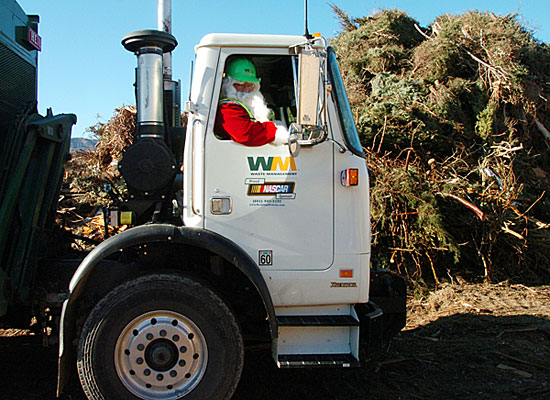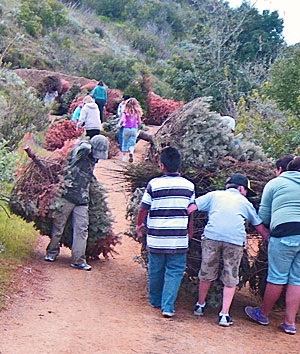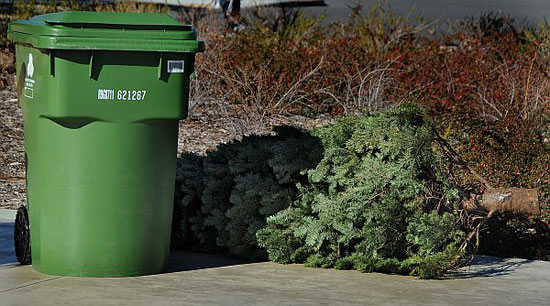Lights out for L.A. Christmas trees
January 3, 2013
The end of the holidays can be such a grind.
Particularly for the hundreds of thousands of Los Angeles County Christmas trees being chopped up, ground down or otherwise looking for a new line of work in the days and weeks ahead.
Yes, it’s the most resolution-making time of the year, and prominent among all the do-good messaging is the mantra to go green by recycling that tree. The city of L.A. is touting the fire safety benefits along with the environmental upside, while the county is promoting convenient curbside pickup to have ol’ tannenbaum transformed into “compost, mulch, or ground cover.” But the reality of L.A. Christmas trees’ final chapter is a little more complicated than it might seem, with different approaches in place in the county’s various communities and plenty of ground up trees ending up covering a variety of sins in local landfills as “alternative daily cover.”
Sure, some of these former glitter kings of the living room go on to a bucolic-sounding afterlife. The 100,000 or so trees picked up by the city of Los Angeles’ Bureau of Sanitation, for example, are made into mulch and used as ground cover here or sent to farms in Kern and Ventura counties. (Residents can pick up a free bag year-round at any of the locations on this city map.) Santa Monica’s Christmas trees—some 25 tons of them—are chipped at local parks and pressed into landscaping duty around town; the 2011 crop is now serving as mulch at the Santa Monica Airport.
In Avalon, teams of fourth-graders, guided by the Catalina Island Conservancy, recycle several hundred trees each year by placing them in gullies where they provide natural erosion control. First, the kids strip off all the tinsel and other “unnatural parts” like ornaments or tree stands, then work together to move the trees to gullies where they’ll hold soil in place and make it possible for new plants to grow.
Other Christmas trees—some 386,235 last year—are off on a whole different kind of sleigh ride. These trees, from unincorporated communities and about 80 cities throughout the county, are picked up by trash haulers and trucked to local landfills, where they’re ground up to become “alternative daily cover”—the stuff they put over the trash every night to keep things tidy and reduce odors. It may not be the most glamorous job on the Christmas tree lot, but somebody’s gotta do it—and county officials say it’s a beneficial form of recycling permitted under state law.
Under the program, trash haulers from participating cities drop off the Christmas trees at the landfills free of charge.
“I personally believe alternative daily cover is a great market for this material. It’s a pretty great use in these urban markets, rather than hauling it away” to be converted into compost at a faraway facility, says Nick Morell, recycling coordinator for the county Sanitation Districts. He said the ground-up Christmas trees take the place of dirt that would otherwise have to be trucked in and used as cover.
The recycled Christmas tree cover also lessens smells, prevents fires, reduces dust and “keeps critters away,” says Pat Proano, assistant deputy director of the environmental programs division for the county’s Department of Public Works.
While composting would be a “preferred option” for retired Christmas trees, Proano says, there’s not enough of a local agricultural market for all that would be produced in a county the size of Los Angeles. “We’re not farmers,” he says. “The quantities are huge.”
Still, Proano says, this year’s planned closure of the county’s Puente Hills landfill, the nation’s largest, will require some rethinking of how the county recycles its Christmas trees before the next holiday season rolls around.
As things stand now, Proano says, most residents are “probably not” aware of where their Noble fir or Scotch pine will end up after their trash hauler picks it up curbside.
“They’re just probably glad to have the service,” he says. (To check out what’s going on in your community, click here for a list of contact numbers and websites. Please note that different cities have different requirements—Los Angeles asks that residents cut their trees into pieces small enough to fit into their green yard waste bins, for instance, whereas Santa Monica requests that trees be kept out of the bin and dropped off at parks. No matter when you live, tinsel must be removed along with decorations and tree stands before pick-up, and flocked trees are generally frowned upon.)
Getting the inside story of what actually happens to the family fir after it’s left at the curb can be a bit traumatic, as a group of Long Beach students learned last year.
“They were totally disillusioned,” recalls Lisa Harris, the city’s top recycling specialist. She says the Rogers Middle School students had wanted to research the happy hereafter of Christmas trees. “They were hoping the trees were going to be turned into a buttery compost”—not pressed into service for “alternative beneficial use” in landfills.
However or wherever a real Christmas tree meets its end, it’s a good environmental outcome, in the view of Rick Dungey, public relations manager for the National Christmas Tree Association.
“There are so many things you can do with it because it’s a plant,” he says. (For instance, discarded Christmas trees in Riverside County are being placed in Lake Elsinore to create fish habitat.)
Dungey’s no fan of the faux tree, which he terms “a giant green toilet brush” that’s destined for a non-biodegradable future in a landfill someday.
His organization estimates that 30.8 million real Christmas trees were sold in the United States in 2011, along with 9.5 million artificial trees. They don’t do regional breakdowns, but that translates roughly to one real tree for every ten residents.
Already looking ahead to next year? Sunset magazine’s take on the pros and cons of real and artificial trees is here. And—just as reusable bags have offered a way around the eternal paper vs. plastic debate at the grocery checkout—there could be a third holiday decorating option to consider come next December: rented live Christmas trees, for those who can’t bear to send their evergreen to the great beyond.
Posted 1/3/13















 405 bridge work causes a stink
405 bridge work causes a stink





